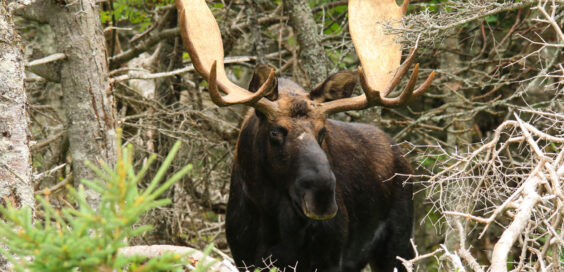
Creature Feature – Moose
Posted by Dustin Horton // April 20, 2022 // Articles, Creature Feature
Although it’s unlikely we’ll encounter a moose in this neck of the woods, the Adirondack Region hosts around 600-700 of these magnificent animals. The moose is the largest member of the deer family. Male moose, called bulls, weigh between 600–1,200 pounds and can stand nearly 7 feet tall at the shoulder! Females, called cows, are smaller. Moose have long legs to help navigate deep snow and wade through water. A flap of skin called a ‘bell’ hangs under their throat. Only bulls grow antlers, which start budding in early spring; they turn bone-hard over time and can reach over 5 feet wide. Antlers are dropped annually between November-January.
Optimal moose habitat includes a blend of mature, mixed woodlands, open areas and wetlands that provide ample leaves, twigs, buds and aquatic vegetation. In winter, moose strip bark from young trees. In summer, they wade into wetlands, reaching beneath and even diving under water for plants. Wetlands also provide relief from biting insects and heat.
Moose breed in late September-October. As bulls compete, their sparring and shoving matches can escalate, causing injuries. Calves are born May-June and stay with their mothers until the following spring.
No predators of adult moose remain in NY State, but black bears, and more rarely coyotes, sometimes eat younger calves. Moose die from auto collisions and are susceptible to deadly parasites like brainworm. Winter ticks are the main cause for mortality in New Hampshire, where one moose can carry thousands of ticks, resulting in extreme hair loss, emaciation and death. Biologists are studying different ways to help moose populations combat winter ticks.
Margie Manthey
Photo: Justin Hoffman













